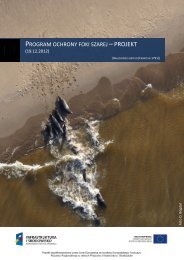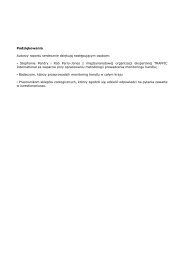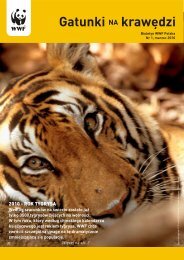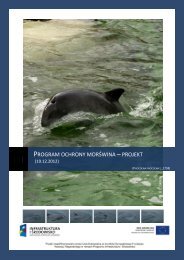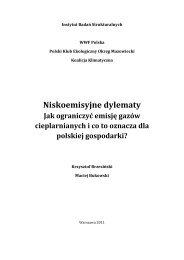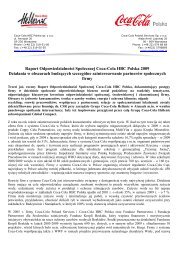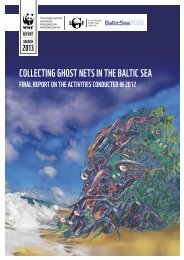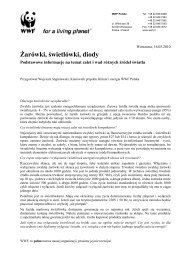MONITORING GLOBALBIODIVERSITYGiven the complexity of global biodiversity, it is very difficult toprovide a complete picture of its overall health. But much as astock market index measures the state of the market by trackingchanges in market capitalization of a selection of companies,changes in abundance (i.e., the total number of individuals in agiven population) across a selection of species can be used as oneimportant indicator of the planet’s ecological condition.The Living Planet Index suggests that across the globe,vertebrate populations were on average one-third smaller in 2008than they were in 1970 (Figure 3). This is based on trends in the sizeof 9,014 populations of 2,688 mammal, bird, reptile, amphibian <strong>and</strong>fish species – many more than in previous editions of the LivingPlanet Report (WWF, 2006b; 2008b; 2010a).Index Value (1970 = 1)2.01.00-28%1970 1975 1980 1985 1990 1995 2000 2005 2008YearFigure 3: The GlobalLiving Planet IndexThe index shows a declineof 28% from 1970 to 2008,based on 9,014 populationsof 2,688 species of birds,mammals, amphibians,reptiles <strong>and</strong> fish.Shading on this, <strong>and</strong>all Living Planet Indexfigures represents the95% confidence limitssurrounding the trend; thewider the shading, the morevariable the underlyingtrend (WWF/ZSL, 2012).KeyGlobal Living PlanetIndexConfidence limitsFigure 4: Turningpopulation trendsinto the Living Planetindicesvertebratepopulations in THEGLOBAL LPI were onaverage one-thirdsmaller in 2008 thanthey were in 1970tropicalpopulation1species1population2temperatetropicalterrestrialspecies2population3GLOBALLPItemperateterrestrialtropicalmarinespecies3terrestrialLPItemperatemarinetropicalfreshwatermarineLPItemperatefreshwaterfreshwaterLPIEach population in the Living Planet Index is classified according towhether it is located in a temperate or tropical region, <strong>and</strong> whetherit predominantly lives in a terrestrial, freshwater or marine system.These classifications are specific to the population rather than tothe species, so some species are included in more than one index.For example, species with both freshwater <strong>and</strong> marine populations,such as salmon, or migratory species found in both tropical <strong>and</strong>temperate zones are recorded separately. No populations aredouble counted. These groups are used to comprise the temperate<strong>and</strong> tropical indices, as well as terrestrial, freshwater <strong>and</strong> marineindices, which together calculate the global Living Planet Index(Figure 4). There are more populations in the temperate index thanthere are in the tropical index. Therefore, to avoid biasing the globalindex toward population trends in temperate zones, the tropical <strong>and</strong>temperate indices are given equal weight in the global index (moredetails on this are included in Annex 1).In addition, each terrestrial <strong>and</strong> freshwater species’population is classified to a realm according to its geographiclocation. Realm indices are calculated by giving equal weight to eachspecies, with the exception of the Palearctic realm where, for thefirst time in this analysis, each family is given equal weight. This wasdone to reduce bias toward bird species, for which there are manymore population records compared to other species in this realm.WWF Living Planet Report 2012 page 18 Chapter 1: The state of the planet page 19
Exploring the Living Planet IndexThe Living Planet Index is a composite indicator that measureschanges in the size of wildlife populations to indicate trends inthe overall state of global biodiversity. Trends within a particularpopulation only show what is happening to a species within aparticular area. To create a robust index, comprehensive populationdata are collected for as many species <strong>and</strong> populations as possiblefrom around the world. While some populations increased duringthe time they have been monitored, others have decreased. Onaverage, however, the magnitude of population decreases exceededthat of the increases, so overall the index shows a global decline.© naturepl.com / Doug Perrine / WWF-CanonFigure 5: Northern bluefin tuna (Thunnusthynnus), Western Atlantic OceanUnsustainable levels of fishing have caused acatastrophic decline in this population sincethe 1970s. Because bluefin tuna has a very highcommercial value, fishing pressure has continued<strong>and</strong>, as a result, the species as a whole is indanger of extinction.Note: Data are from International Commissionfor the Conservation of Atlantic Tunas (ICCAT)cited in Safina <strong>and</strong> Klinger, 2008.60,000Spawning stockbiomass (tonnes)019712004Figure 6: European otter (Lutra lutra),DenmarkAfter suffering serious population declines inthe 1960s <strong>and</strong> ’70s, improved water quality<strong>and</strong> control of exploitation helped a recoveryin Denmark from 1984 to 2004, as well as inseveral other countries.Note: Data are from Norm<strong>and</strong>er et al., 2009.450Otter numbers019842004Figure 7: W<strong>and</strong>ering albatross (Diomedeaexulans), Bird Isl<strong>and</strong>, South Georgia, SouthAtlantic OceanThis population has been in steady decline since1972. The primary cause is believed to be incidentalmortality from entanglement in longline fishingequipment. One proposed measure to protect thisspecies is to design <strong>and</strong> implement longlines thatmitigate this bycatch.Note: Based on unpublished data from theBritish Antarctic Servey long-term monitoringprogramme 2012.1,800Population size(breeding pairs)019722010View from below of silhouette of diver <strong>and</strong> Atlantic sailfish (Istiophorus albicans) attacking baitball of Spanish sardines / gilt sardine / pilchard / round sardinella (Sardinella aurita) off YucatanPeninsula, Mexico, Caribbean Sea.WWF Living Planet Report 2012 page 20



